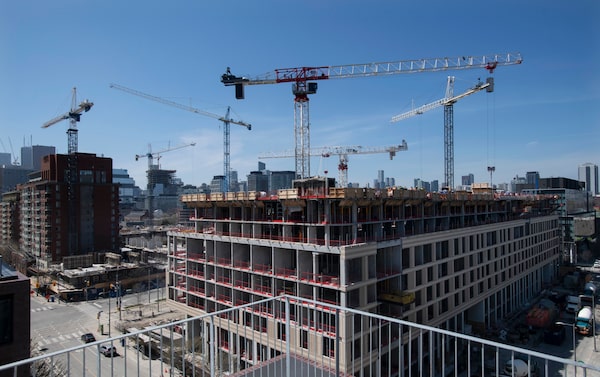
Construction cranes work at several residential developments in the Canary and Distillery Districts in Toronto, on April 27.Fred Lum/The Globe and Mail
By now the consensus has more or less become set in stone. Why are housing prices in Canada so high – fifth highest, relative to income, in the OECD? Well, it’s obvious, isn’t it? It’s because we’re taking in too many people. Supply and demand and all that. Common sense, really.
The same goes for our stagnating standard of living. Canada’s GDP per capita is no higher than it was in 2017; labour productivity, having fallen for five consecutive quarters, is back to where it was in 2014. That, too, we are told, is on account of there being too many people about. Again, simple math, right? More labour relative to capital equals less investment per worker equals lower productivity. QED.
Or health care. Wait times are now three times what they were 30 years ago. Must be because of all of those immigrants.
It’s true that Canada’s population has been growing over the past year or two at rates that exceed recent experience: a million more people last year, probably at least as many this year.
Of course, that’s coming off a relatively slow year in 2021, when the population grew by only 200,000 and change, but still: We’re looking at an average population growth rate, over the past three years, of nearly 2 per cent annually. And yes, most of that has been the result of immigration.
Of course, 2-per-cent population growth isn’t especially high by historical standards. From 1946 through 1982, that was the average growth rate; throughout the 1950s, indeed, it was well in excess of that mark. I do not believe the 1950s are commonly associated with either sluggish growth rates or housing shortages.
For that matter, soaring house prices and lagging productivity growth – and health care wait times – have been issues in Canada for many years, long before population growth began to take off. As they are in other advanced countries, with stable or even falling population numbers.
So perhaps the case that Canada, of all places, suffers from Too Many People may not be quite so self-evident as it may have first appeared. If GDP per capita is straggling, is it because of the denominator (population) or the numerator (GDP)? If housing prices are soaring, is that because of the demand, or the supply? Is the problem too many people, or too little of the investment and housing needed to support them?
It would be one thing if the supply of either were running flat out – if investment or output or housing starts were at record or even unusually high levels, but still could not keep up with the torrid growth in population. But such is not the case.
I suppose it’s possible to connect the relative stagnation of per capita GDP over the past several years to the surge in population over the last two. But it’s surely at least as significant that GDP growth itself has slowed markedly throughout. At roughly 1.5 per cent a year, after inflation, GDP growth since 2014 has averaged less than a third of what it was in the 1950s.
The same with housing. Maybe you can put the current level of house prices down to the number of people living here. Or maybe we should look at the number of houses. At 424 housing units per 1,000 residents, economists at Scotiabank have observed, Canada has the lowest supply of housing of any G7 country.
Why? Because the supply of housing in recent decades has slowed to a trickle. Housing starts, at roughly 260,000 annually, are lower now, in absolute terms, than they were in the early 1970s, when our population was barely half what it is today. Adjusting for population, the rate of housing starts is a third less than it was in the 1960s and 1970s (600 per 100,000 population versus 900).
If we were still building as many houses, proportionately, as we did then, we’d be adding more than 400,000 units a year, and no one would be talking about a housing shortage. We’re not overpopulated, we’re underhoused.
It’s just too simple, in other words, to look at the number of people, or the growth rate, as our neo-Malthusians would have it. It’s certainly true that an increase in population, given a fixed quantity of investment or housing, will lead to increased pressure on these resources. But these quantities aren’t fixed, or certainly needn’t be. If they are, it’s worth asking why – notably, what contribution ill-considered policy might be making to this.
As, in fact, we now are. What can be said about population growth is that it makes the costs of bad policy more apparent. If it means we are now beginning, at long last, to have a serious conversation about the barriers to investment and housing construction that have bedevilled this country for decades, then hallelujah for all those extra people, and let’s have lots more.